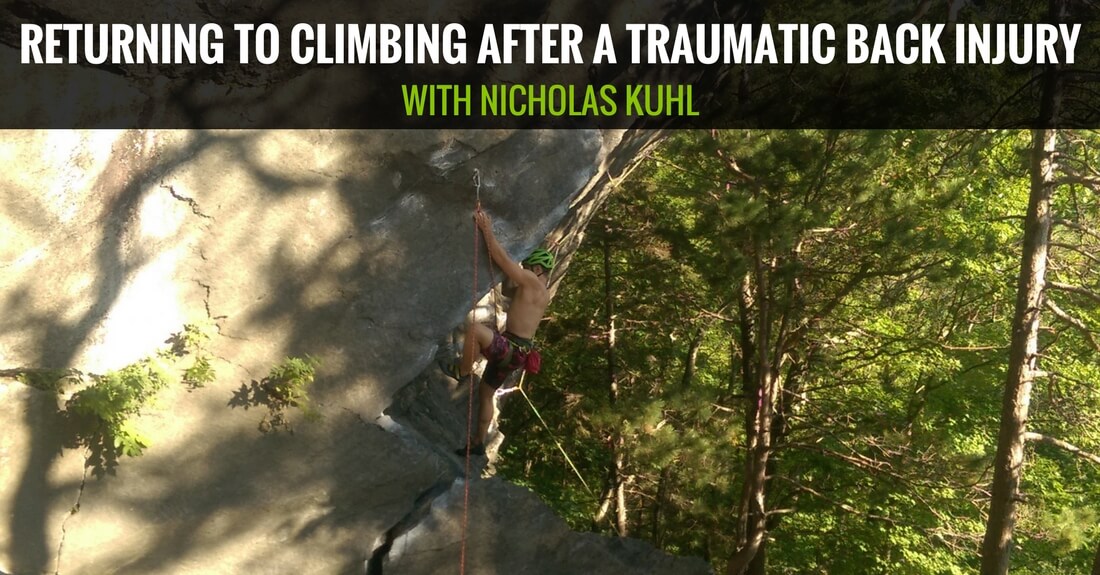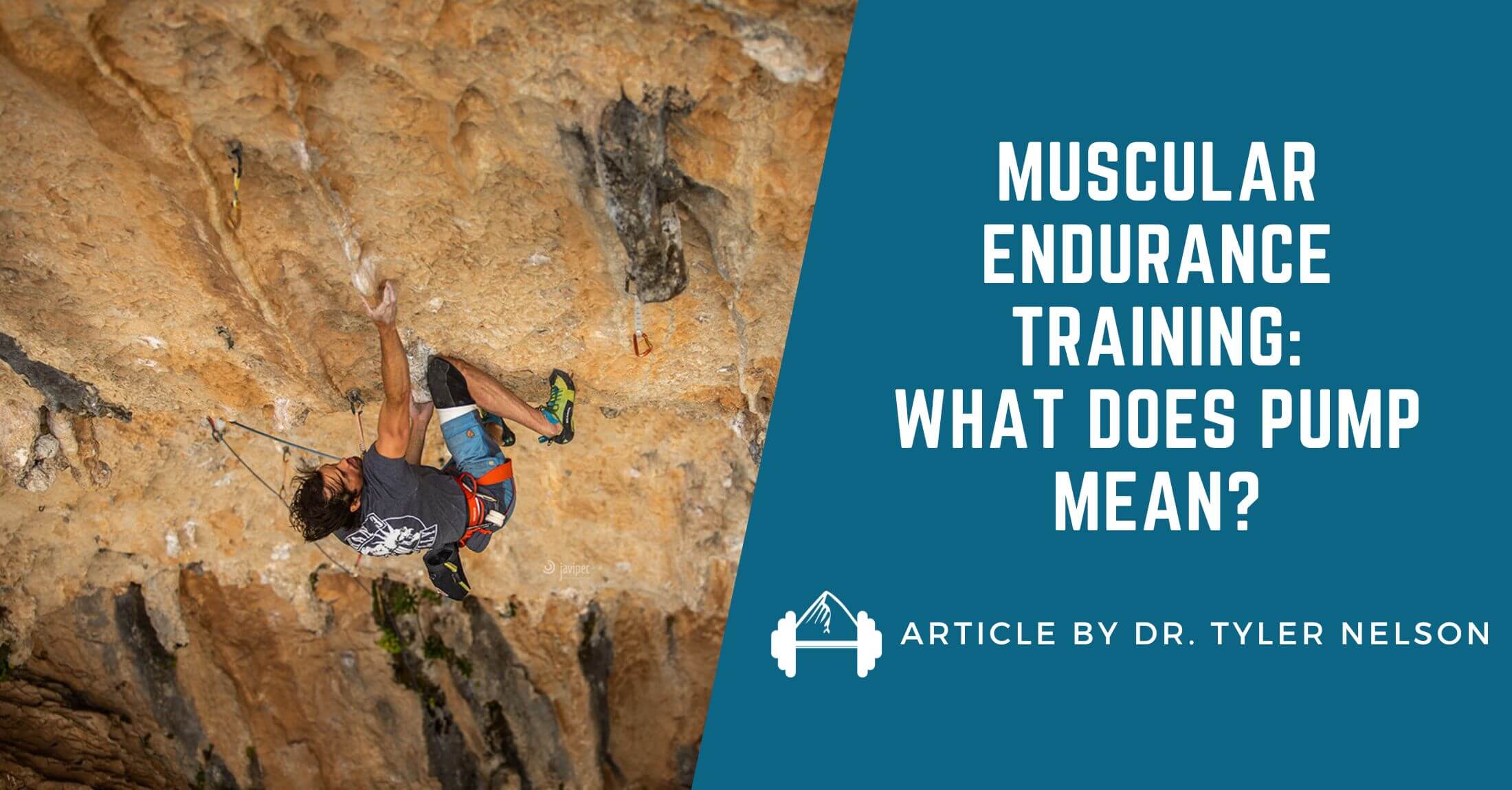We talk a lot about how most climbing injuries are preventable. While this statement is definitely true, it pertains mostly to overuse injuries and doesn’t account for the fact that climbing has some inherent dangers. Injuries that are the result of climbing accidents happen and can be very serious. Depending on the injury, the road to recovery can be quite long.
However, today we’re excited to share a piece Nicholas Kuhl wrote for us about his road to recovery after a traumatic back injury after a climbing accident. We’ll let Nick take it from here, but suffice it to say this is more than just a motivational story. Nick shares the details of how he changed his training and how that helped him not only recover from his back injury but also climb stronger than ever.
Returning to Climbing After a Traumatic Back Injury
On August 31 of 2015, I took a 25’ ground fall (I ripped two pieces of marginal gear) off a mediocre trad line that I thought would be well within my ability. I fractured the transverse process on my L2 vertebrae, had a minor pneumothorax (air bubble knocked out of my lung into my chest cavity), my 10th concussion, an associated brain bleed, and spent 2 nights in the hospital under observation.
On August 29th 2016, I made three new 5.12 redpoints in a single session, and within the next month worked up to sending nine 5.12s in a session (my friend and I were trying to work up to a 12×12 day, but we didn’t make it that season). In the span of a month, I tripled the number of 12s I’d sent in my entire climbing life. I’ve been told that my recovery from the fall and subsequent climbing performance is pretty remarkable, and Neely expressed an interest in learning more after I mentioned my training to her during a nutrition consult. So, here’s my journey from barely being able to walk to climbing again.
Injury and Immediate Aftermath
In the immediate aftermath of the fall, I have a 3-hour memory gap courtesy of the TBI (traumatic brain injury) and I reconnect with the world in the Conway ER. From there, I was transferred to Maine Medical, which was largely unremarkable, aside from the fact that there is not enough morphine in the world for an ambulance ride through the back roads of New England.
There were many rounds of CT scans and painkillers, and the only other moment of note was when one of the attending physicians suggested to me something along the lines of “you know, your back will never be 100% again, and you might not climb ever again.” I’m fairly certain I said something to the effect of “Fuck that!” though I may have just mumbled and drooled.
This, I think, is the first lesson of rehab and recovery: you must believe and be 100% committed to coming out of it as a high-performance human being. If shit happens and you simply hope to passively get better, you won’t. I woke up in the hospital 100% sure that I was going to climb and trail run and generally get rad again. The second lesson I learned is that recovery and rehab are not about getting BACK, you’re building a NEW you, and you should strive to end up better than the old you.

Nick staying positive and keeping his spirits up | photo courtesy of Nick Kuhl
When I got back to Boston, I got extremely lucky with a recommendation to a doctor in a sports medicine clinic who is on the cutting edge of TBI care, and shares a roof with a team of excellent physical therapists (shout out to Dr. Comeau; Lisa Brown, DPT; and James Camarinos, DPT, who provided incredible care at the Boston University Ryan Center for Sports Medicine. The other key components of my rehab were Liliana Driever, soft-tissue and movement master, now of EDX Bodyworks, and Jessica Shaw, my acupuncturist).
Brain injuries are terrible. The first few weeks especially. It took weeks before I could read again, and longer before I could look at screens for any period of time.
Thankfully, friends visited often and my parents and in-laws were able to come and help take care of me, as I was basically couch-bound and my wife was severely injured at work a week later (it was a rough couple of months in our house). My wife and I live in an 800 square foot apartment, and it would easily take 5 minutes for me to get from the couch to the bedroom: every step was a battle through the back pain and the fog of brain injury.
The Early Recovery Process
I started physical therapy on the fairly aggressive timetable of a week and a half after the injury (this was possible because the vertebrae was a stable fracture). My major back muscles were in total lockdown 24/7, so the main goal of PT at this point was to get the minor stabilizers going again and doing their jobs so the larger muscle groups could relax. This involved a broad range of pully and bodyweight exercises, in addition to some easy kettlebell work. To be frank, it was mostly really goddamn miserable and tedious, but definitely worked.
After about 6 weeks of closely guided physical therapy, I was cleared to start lifting again, as long as I abided by my body’s pain signals. I had a pretty hard limit around 95# for squats and deadlifts (my back still wouldn’t tolerate overhead pressing), and pull-ups worked as long as I maintained a very strong hollow-body position.
Within that weight limit though, I could rep out as much as I wanted, so 3 days a week, I went to the gym and squatted 95# x 5 x 20, and deadlifted the same. I also walked as much as possible, abiding by the idea that movement is medicine. I had a couple of weeks of this sort of high volume, low-intensity work before the pain ceiling really started to go away. Climbing was still a ways off (stable, predictable loads that I could brace for were easy to handle; unpredictable loading, especially laterally, was a very different story), but in early November, I was given the go-ahead for increasing loading for real.
In parallel with this, I was slowly returning to work (I’m a designer for an architecture firm in Boston, and am also working on my Master’s in Architecture). During this period I was having a lot of problems with depression (a common result of TBIs), and I was missing 1-2 days of work per week because I was unable to handle the idea of leaving the house in the face of said depression. At some point, I realized that these were all on rest days (I habitually train in the morning so I get that endorphin fix early), so I started doing a shitload of research into high-frequency training models. Following something along the lines of Dan John’s Easy Strength program (it might have actually been Even Easier Strength), I did some form of a squat (alternating days between front and back) every day, and followed it with either overhead pressing or deadlifts. On November 30th, I solidly hit a then all-time deadlift PR of 305# for reps (and blew that out of the water a few months later).
Return to Training
The success of this initial foray into high-frequency training led me down a pretty deep rabbit hole that included discovering Matt Perryman’s excellent book, Squat Everyday, a ridiculous article on T-Nation called 10,000 Swings to Fat Loss, and reading a lot of stuff by Greg Nuckols and Nick Horton (his Squat Nemesis program was the template I later used for my daily squatting).
Around this time, I started climbing again, and after about a month of having panic attacks at the top of the bouldering walls, I was mentally and physically able to start taking real falls again in the new year.
The final key influence was an article Steve Bechtel published in January or February of 2017, wherein he suggested a link between the body’s hormonal response to high-intensity resistance exercise (as in, heavy lifting) and improved gains on the hangboard when the two methods were combined in a single session. Between that, and Squat Everyday, I think you can see where this is going. Since the Y doesn’t have a hangboard, I convinced my wife that having a barbell in the living room would be great, and bought a barbell and some bumpers, and improved our home training rig so that it would serve as a power rack.

Nick’s home training zone| photo courtesy of Nick Kuhl
I spent January and much of February building frequency and volume on the hangboard. I think it’s key to build these two variables first on the road to high-frequency training, in order to improve your body’s recovery capacity. Then, you can begin to layer in high-intensity sessions.
Ultimately, from February 28th to April 8th, I front squatted to a 2 rep technical max (heaviest possible with good technique), did between 3 and 7 back off sets (depending on the weight and how good I felt), and superset every set with heavy hangs from a 20mm edge, on every single weekday. I slowly added weight on the board, first adding volume to each set, then dropping the volume and increasing the weight in ascending waves.
By the time I finished that period, I had doubled my hang weight to 32kg and put 60# onto my squat.
Beyond this routine, I also bouldered in the gym every Saturday, and once I was able to start running again, I ran my 4.5-mile commute home a couple nights a week and went for a longer trail run early every Sunday morning.
Now, there are a few other considerations that went into all this. First, I knew that I was going to be super busy between work and a particularly intense semester of school, so even getting to the climbing gym was only going to happen on the weekends no matter what I did. Second, finger strength relative to the rest of my strength and power has always been a weakness of mine, so having a period of absolutely maniacal focus on it seemed like a good idea. Third, I did other exercises as well as the squats and hangs: every session started with 5 minutes of easy movement (a lot of crawls and rolls), and then 10 minutes or so of press, hinge, and pull work as a circuit, so all the basic movement patterns were at least somewhat covered.
Return to Climbing
By April, I was getting pretty fried from the maniacal focus, and dropped squats to once a week and brought in some more variety of exercises. However, I kept the heavy hangs going a minimum of 3 times per week through July, and I eventually hit 40kg on that 20mm edge before deciding it was time to work on some smaller edges.
Freed from school over the summer, I added in two weekday climbing gym sessions and kept three days a week of strength training going with a mix of different modalities. My climbing and strength sessions were always morning sessions, and 3-5 nights a week I would run in the evening, waving session volume and intensity over the course of the week. My morning climbing sessions were endurance focused for July and August, and I capped them typically with some sort of horrendous sub-10 minute conditioning circuit.
Towards the end of August, conditions were good and a friend of mine invited me to join him for his 12×5.12 in a day project, which is apparently the late summer ritual of all the local hard-people in my neck of the woods. It’s a remarkably fun and fairly effective way to build some specific base volume for later season sending and getting in repeat attempts on hard lines. The finger strength and general work capacity I’d built paid off big time. Once I got past the jitters of being back on real rock, I found myself the best climber I’ve ever been (and at by far the heaviest weight). Almost exactly a year to the day after almost dying, I pulled off 3 new redpoints in a single session, and a couple weeks later, I managed 9×5.12 in a day.

Photo courtesy of Pedal Power Photography
Major Take-Aways
Here’s a few final thoughts.
Even though I didn’t plan it all out ahead of time, I think I did a reasonably good job of applying progressive overload to my build towards high-frequency strength training: increase one variable at a time. Have your normal strength training days in the week, and start by adding in just 1 or 2 heavy reps on an additional day and get used to it. Repeat until your week is all heavy days, and then go back and start adding the volume. Or, you can do like the Norwegian powerlifting team, and take the total weekly volume of a normal strength training program and average it over 5-7 days (up to you how much intensity per session you want).
One of the things that I think is a major benefit of lifting is the ability to carefully and progressively train your body’s recovery capacity, which is something that seems lacking in a lot of climbing training. It’s important to realize that if we want to get stronger (even if it’s just in our fingers), over time BOTH volume and intensity must go up to drive progress (smarter people than me have explained this, check out: https://www.strongerbyscience.com/increasing-work-capacity/). By increasing these in small increments, we train our ability to recover. It’s hard to make controlled steps using bouldering problems, but really pretty easy using squats or deadlifts and recovery capacity seems to be a pretty general adaptation.
On a final note, I hinted at being heavier than I used to be earlier: in the 2-3 months that my activity was really limited, I gained about 10# (which is what happens when you’re used to eating for 10-20 hours a week of training, and then you don’t). I consciously decided that I wasn’t going to cut calories to try and drop that weight, but that I would just train my face off, eat reasonably, and see what happens. Well, I sent my 9×5.12 in a day at 5’9 and ~185# and probably around 10% body fat. That’s the heaviest I’ve ever been and sent a 12, but it’s also by far the healthiest and toughest I’ve felt. If my goal in climbing was to send 5.15, I might be concerned (though probably not), but I’m after big mountains and big walls in the long run, as well as longevity as an athlete, so I think being heavier is ok, especially since it’s been paired with both absolute and relative strength gains. So, get strong, train hard AND smart, eat well, and send hard!
Cover Photo courtesy of Russ Ney

Nick is a sport climber with an alpinism problem, who enjoys training more than is reasonable. He is happiest when groveling through dirty sufferfest pitches or engaging in endurance pursuits in the rain, and he helped FA Peru’s worst ice climb. Sometimes, he designs buildings.





Hello, my name is Ethan. I’ve been climbing for about 6 months. I was a solid 5.10B climber. I feel from a tree at work and burst fractured my t12 vertebrae. They fused my t11-L1. I love climbing more than anything. This happens about 30 days ago, I’m still in a turtle shell. I haven’t started PT yet. My goal once I can train is to spend the next year devoted to being the best climber possible.
I have a few questions.
Do you recommend trying to find a sports PT specialist?
Do you have any trying exercises I can do tat doesn’t involve my back?
Once I can start training do you have any good recommendations or resources?
I will probably come up with more. I found your page looking for climbers who had broken their back.
I would greatly appreciate any help or information.
Kind regards
Ethan
Hi Ethan – I talked with Nick (the author of this article) and here’s the gist of what he said about your situation. Let me know if you want me to get a PT recommendation from him for you, but your doc should have a good recommendation for you, too.
“Yeah, he needs a really good PT, and then maybe a coach? He can always spend all his couch time reading Bechtel’s books / training plans and then put something together for himself. But I think, given the injury, the best recipe for success is good PT followed by good coaching. There’s probably going to be a lot of movement compensation to deal with after something like that. Where’s he located? I might be able to help find PT recommendations for him.”
I live in Asheville North Carolina. I would greatly appreciate any help/recommendations.
I have to deal with workman’s comp insurance. But hopefully they will be easy to work with when it comes to the PT specialist I choose. I don’t know if any coaches in the area but if you know of anyone that would be great as well. I go back to the doctor on Friday. Fingers crossed I’ll be recasted to start excessing.
Thank you so much for reaching and and responding to my comment.